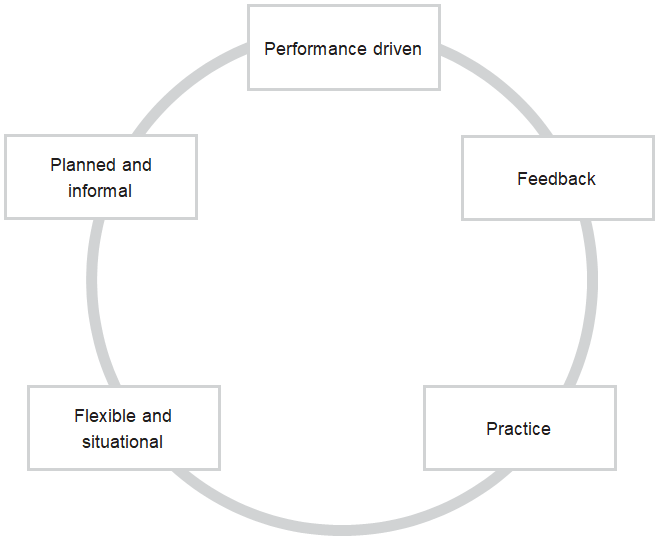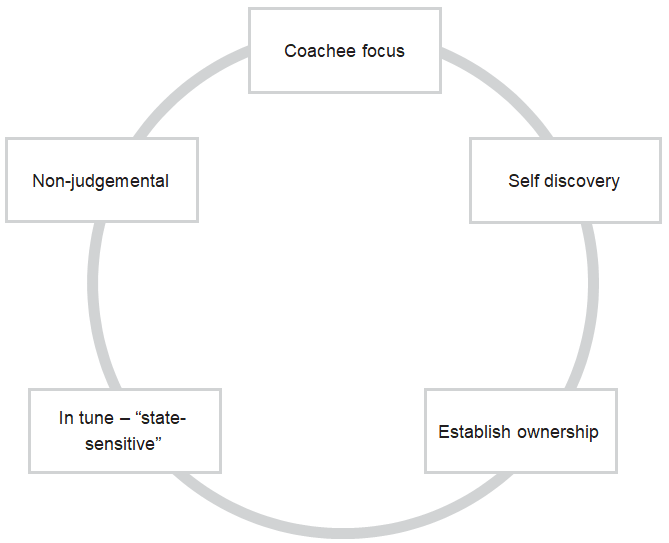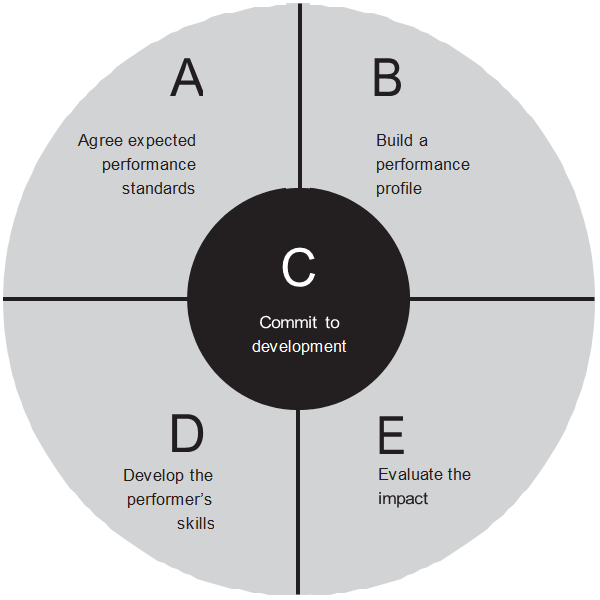Chapter 3
Principles, Skills And Our Model
The foundation of Procoach
Procoach: our reasons for this approach
“Always make a total effort, even when the odds are against you.” ARNOLD PALMER
Key chapter points
- The values that underpin effective performance
- The need for a coaching mindset to create optimum conditions for
- Observable behavioural skills we recommend as a Procoach
Performance driven
People evaluate and measure coaching by different indicators and methods, and this can be because of the different problems coaching looks to tackle. At Prosell we believe that coaching is only effective if it delivers improved performance. We develop coaches who can bring out the best in their people and contribute to the results of the business and team they represent.
Performance Results
At the heart of Procoach is a set of foundations, which we believe make the difference between a good and great performance coaching experience. Understanding the rationale behind the programme’s design will help you identify how Procoach can benefit you.
The five foundations of the Procoach approach are:

Explaining our values
Performance driven
A coach taking a successful performance-driven approach places an emphasis on measuring their coachee’s behaviours, working practices and performance results. With appropriate support from their coach, coachees are engaged in analysing their performance and creating their own self- administered development plans. Depending on the circumstances, it may be necessary to challenge the coachee to help them acknowledge or build awareness of improvement opportunities.
Feedback
To develop their working practice, a coachee needs to be aware of what they are doing and why. Without effective feedback, this is virtually impossible; enhancing self-awareness, through feedback, is the precursor to development.
Effective performance improvement coaching involves the coachee analysing their performance. The coachee should then discuss their conclusions with their coach in an open and candid conversation.
Practice
To improve skills in the workplace, there is no substitute for practice. Procoach uses a specific coaching approach to help the coachee learn or refresh skills based on prior experience, or modelling others.
Our experience of coachees from different organisational backgrounds has convinced us that an effective environment is one where the coachee is able to practice in a risk free environment. The importance of disciplined,
challenging practice as an essential component of success (“it must be lived and learned”) is confirmed in research carried out by other writers in this field (Syed, 2011).
“For every failure, there’s an alternative course of action. You just have to find it. When you come to a roadblock, take a detour.”
MARY KAY ASH
Flexible and situational
We believe that an effective coaching experience is one where the coach alters their approach to reflect the capability, experience and attitude of the coachee. For example if the coachee is very motivated, knowledgeable and skilled, the coach will adopt a more hands-off style. This will involve more asking rather than telling the coachee how to do things.
If coaching is flexible and situational you would expect to see a coachee who is very engaged in the conversation or practice.
In terms of recognising the type of coaching needed, we recommend that the coach discuss how the coachee wants to be coached from the outset to identify the optimum “coaching” approach.
Planned and informal
Effective performance coaching can be both planned and informal.
We designed our Procoach approach for use in both situations. You can use it effectively during a formal performance review and development process and during a spontaneous “do you have a minute…”coaching conversation.
In both cases, the coach would help the coachee identify areas of performance potential, or where it is possible to enhance existing good practice. They then use Procoach behaviours to address the situation.
The precise method of introducing a coaching approach into an organisation will depend on the nature of the business. Procoach has delivered continuous, tangible performance results in a cross section of business types, markets and countries.
“We first make our habits, and then our habits make us.” JOHN DRYDEN
An optimum coaching mindset
In Chapter 1 we introduced the idea of a coachee’s mindset. We contend that a coachee needs a growth mindset to provide the optimum conditions for performance improvement. It is equally important for a coach to adopt a coaching mindset; one that provides the coachee with the most advantageous environment in which to grow.
As part of the Procoach programme, we introduce these principles:

We believe that a coach can be highly effective if they are able to apply these principles to the coaching situations they encounter and therefore adopt an effective mindset.
The Procoach principles: defined
Here is a description of the Procoach principles and examples of how to recognise if they are being applied.
1. Coachee focus
What it means
The focus is on the coachee and their needs
The focus is on the coachee and their needs. This increases the chances of the coachee being engaged and maximising their potential.
The coach will constantly engage, support and involve the coachee. Look for eye contact, verbal nods and other physical signs of giving attention to the coachee.
2. Self discovery
What it means
What you would look for
The coachee is encouraged to participate, to increase their awareness of their performance, the reasons and their options to develop or enhance their working practice. The coachee physically and emotionally experiences the learning.
Coaching discussions or practical skills coaching where the emphasis is on asking the coachee to do or discover something.
For example, a coach might ask a coachee to think about the impact of their behaviour, or to come up with ideas based on their experience.
In practical skills coaching, this often involves the coachee in practice and feedback exchange.
3. Establish ownership
What it means
What you would look for
An environment is created in which the coachee takes ownership for their development.
The coachee will suggest where they need support. The coachee will also be self aware of their skill, knowledge and motivation levels.
4. In tune – “state sensitive”
What it means
What you would look for
The coach is ‘in the moment’ with the coachee’s current state. The coach uses different behaviours to engage the coachee effectively.
The coach will use similar language and check that the activity has benefited the coachee. The coach and the coachee might also mirror body language and use similar words.
5. Non-judgemental
What it means
What you would look for
Building trust means the coachee can express themselves freely. This creates a learning environment in which a coachee shares ideas, makes discoveries about themselves, and practices skills without fear of judgement.
The coach asks questions which are non-directive. Their questions and responses demonstrate acceptance and support of the coachee irrespective of what they say or do. They will seek to understand the coachee’s beliefs and concerns by exploring the topic, rather than jumping to conclusions.
Case Study
David reviews his coaching mindset:
Looking back at his performance review meeting with Emma, David decides to examine his mindset and evaluate whether he is measuring up as a coach.
He considers each of the mindset principles in turn.
Coachee focus: David is confident that he had coached with Emma’s best interests in mind. Although he initiated the discussion about her reports, Emma recognised that she was struggling.
Self-discovery: Emma struggled to identify the cause of her challenges at first, but David was pleased that his questions helped her reach her own conclusions about the help she needed.
Establish ownership: During the conversation, David was pleased to observe that Emma felt a responsibility to improve her report writing skills. So he focussed his attention on helping Emma arrive at a solution that would work for her; spending some time with Jan.
In tune, “state sensitive”: Emma had been ready for an open discussion about her performance on this occasion. David felt he’d responded in kind, acknowledging her comments about the number of calls she was receiving from other teams and confirming her concerns were something that she needed to address.
Non-judgemental: David worked hard in earlier discussions with Emma to help her become less cautious when discussing performance gaps. The most recent discussion showed that this caution had disappeared; David had been able to respond with more questions and feedback about the difficulties she had faced than when they started.
“You can’t cross the sea merely by standing and staring at the water.” RABINDRANATH TAGORE
Chapter check
What have you learnt from this chapter?
In this chapter, we described the foundations of our Procoach programme and some of the skills that support our approach to performance improvement.
Check your knowledge by answering these questions:
Self-assessment questions
- What are the values of the Procoach approach?
- What mindset does a coach need, to allow them to carry out effective performance improvement coaching?
Chapter 3 – Summary & Actions
In this chapter we:
- Summarised the Procoach Model of performance development
- Identified why an individual may have development needs
- Outlined the components and elements that comprise the Procoach programme
Your action plan
Consider the actions you will take to encourage performance
improvement in your team, department, or company.
Ask yourself:
- Which of the values we have described in this chapter can you relate to? Which might you wish to work on?
- How appropriate is my mindset when I am coaching others?
Make a note of any aspects that you feel you can improve. Then plan how to make a start on the areas you’ve identified.
“Alone we can do so little; together we can do so much.” HELEN KELLER
The Procoach A-E model
Bringing about change in an organisation can take some effort. Your attempts to change and grow may be met with indifference, or even active disagreement. The benefits however are significant. Imagine what you could achieve if you persevere in your efforts to adopt best practice coaching into your organisation. What difference could it make to you, your team and your organisation?
In the following chapters we examine the Procoach A-E model in more depth. This model provides a framework through which to structure effective coaching.
In this framework, we offer additional tips to putting performance coaching into action, demonstrating how you can use the tools we examined in the last chapter via this framework.
After reading these chapters and the supporting information we’ve already introduced, consider how you can use the concepts described to effect change and grow as an individual.
The Procoach A-E model

